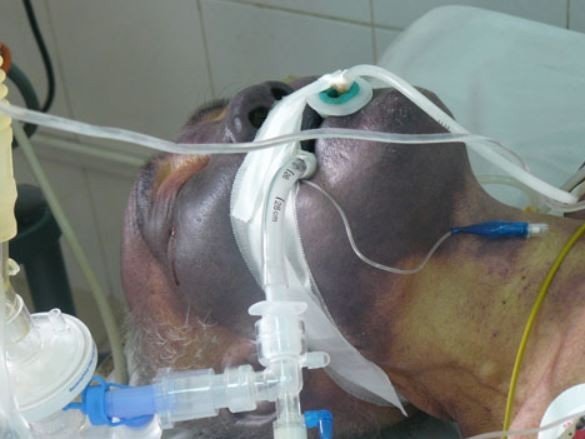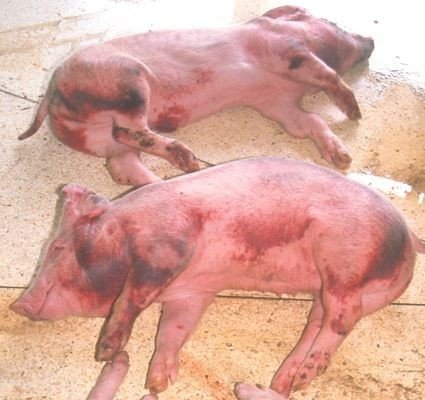STREPTOCOCCAL INFECTION
Disease Agent
Streptococcal disease in pigs, also known as Streptococcus infection, is caused by Streptococcus suis, a bacterium commonly found in pigs worldwide. This bacterium resides in the tonsils and does not typically cause illness under normal conditions.
However, under adverse conditions such as stress, the bacterium can cause various diseases in the host, including meningitis, pneumonia, “thin pig syndrome,” arthritis, endocarditis, myocarditis, pericarditis, polyserositis, and abortion. Streptococcal infection is a secondary disease that prevails in cases of Porcine Reproductive and Respiratory Syndrome (PRRS), leading to significant losses in the livestock industry.
In addition to causing pig deaths, the disease can lead to meningitis, deafness, and multi-organ failure, which can be fatal to humans (through consumption of undercooked pork, such as blood pudding or rare pork dishes).
A dangerous source of the pathogen is the pig’s drinking water, including water from wells drilled 30-40 meters deep.

Humans contract Streptococcus from pigs
Symptoms
Pigs of all ages can be infected with Streptococcus bacteria, but newborn piglets and weaned pigs are most commonly affected. The incubation period ranges from 1 to 2 days, and can sometimes be as long as 7 days.
In acute cases, pigs can die very quickly. Infected pigs may exhibit very high fever, loss of appetite, lethargy, disorientation, and weakness. Some may show neurological symptoms such as loss of balance, sitting posture similar to a “sitting dog,” unsteady walking, arching of the back, trembling, and convulsions. Others may become blind, deaf, walk with a limp, or become crippled. Arthritis can occur in chronic cases.

Lesions:
In pigs that die from acute or subacute forms of the disease, post-mortem examination reveals significant hemorrhage in serosal and mucosal surfaces. In cases of meningitis, there is swelling, blood accumulation in the brain and meninges, and an increase in opaque cerebrospinal fluid. In cases of septicemia, the carcass appears red, with swollen organs and lymph nodes. There may be fibrinous pericarditis and proliferative inflammation of the left ventricular valve. In cases of polyarthritis, pus may be present. The carcass may exhibit bleeding from the mouth, nose, and a tendency for blood to clot poorly.
Blood accumulates in the thoracic and abdominal cavities, with fibrinous exudates covering the pleura, pericardium, omentum, and liver surface. The apical and cardiac lobes of the lungs may become consolidated, sometimes with hemorrhagic areas and caseous inflammation. The spleen is swollen and dark red, with a tense capsule and rounded edges. Under the splenic capsule, there may be pinpoint or patchy hemorrhages. The spleen appears firm and rubbery to the touch.

Streptococcal Disease in Pigs
Diagnosis:
Diagnosis is based on clinical symptoms, epidemiological investigation results, and examination of tissue samples, blood, inflammatory exudates, or joint fluids.
Differential Diagnosis:
It is important to differentiate from other diseases such as:
- African Swine Fever: Causes meningitis with neurological symptoms.
- Classical Swine Fever: Affects piglets more severely, with symptoms like standing on their forelimbs.
- Foot-and-Mouth Disease: Can also cause arthritis and distinct skin lesions.
- Haemophilus: Leads to pneumonia and upper respiratory infections.
- Pneumonia and Pleuropneumonia in Pigs: Involves pneumonia and pleurisy.
- Toxoplasmosis: Causes high fever and pneumonia in piglets; adult pigs may be weak and shivering but without fever; sows may experience abortion, stillbirth, or premature birth.
Differentiation is also needed for “Stunted Piglet Syndrome” from emaciated pigs due to poor nutrition. Since weaned pigs die suddenly with neurological symptoms, differentiate from “Head Edema Syndrome” and PRRS.
Treatment:
Supportive Care:
Provide good nursing care to minimize stress, maintain proper density, ensure well-ventilated and clean housing.
Avoid bleeding surgeries (tail docking, ear notching, castration) which can exacerbate the disease.
Disinfect with products like VINA SAFE PLUS, VINADIN, or B.K.VET, and use fly control products like VINAMOS (10 ml/liter of water, spray every 10-15 days) since Streptococcus can survive on flies for over 5 days.
Medication:
This disease is treatable; earlier intervention yields better results. Neurological cases with convulsions are difficult to treat. Both herd and individual treatments are necessary.
Administer one of the following for 5 days:
- Vinacol or Vinaflor 4%: 1 g/20 kg body weight per dose, twice daily or 1 g/liter of water.
- Vina-flo Oral 20%: 1 ml/4 liters of water or 5 ml/400 kg body weight per dose, twice daily.
- Vinaflocol 50%: 1 g/10 liters of water or 1 g/200 kg body weight per dose, twice daily to kill bacteria.
- Simultaneously administer Panadol TW1: 10 g/150 kg body weight per dose, twice daily to reduce fever. This drug is safe for pigs with hemorrhagic symptoms.
- Electrolytes + Bcomplex: 10 g/4-10 liters of water or 100 g/400-1000 kg body weight per dose, twice daily or Stress-bran: 1 g/2.5-3 liters of water until the fever subsides.
For individual symptomatic cases:
Inject 3-5 doses of one of the following antibiotics: Vinaflocol: 1 ml/15 kg body weight per dose, 2-3 doses every 48 hours; Gentamox, Tyloflovit, Flordoxin: 1 ml/10 kg body weight per dose; Gentatylodex: 1 ml/12-15 kg body weight; or Vinaenro 5%: 1 ml/20 kg body weight, once daily.
Intramuscular injection of Vina-paragin: 3 ml/10 kg body weight per dose or Analgin C: 1-2 ml/10 kg body weight per dose, 1-2 times daily to reduce fever.
Do not use aspirin or ketoprofen to reduce fever, as they can exacerbate bleeding.
Prevention:
Maintain good veterinary hygiene practices, regularly disinfect and decontaminate facilities, and actively control flies. Provide proper care to minimize stress, ensure adequate ventilation, and avoid overcrowding. Minimize the need for surgeries.
Prepared by:
Technical Advisor – Vinavetco
Dr. Tran Van Binh
0981.928.956
